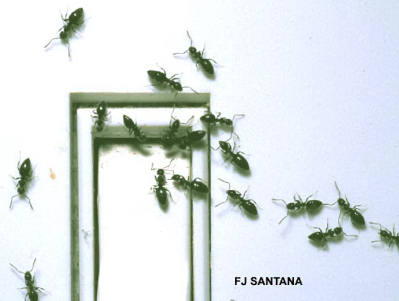White Footed Ants
White Footed Ant Control (using Liquid Ant Bait)
They donít bite; they donít sting; but they sure get into
everything.
The white footed ant is the most notorious recent invader of Florida.
Originally a native of Southern Japan and its neighboring islands, this
ant specie has been on the move north and west from southeast Florida.
Identified by entomologist Mark Derup in 1991, the white foots are
believed to have settled in the Homestead, Florida area in the mid 1980ís.

White footed ants invading a wall switch by Fred J. Santana, Entomologist.
Originally thought to be a minor problem, the white footed ant reached
pest alert status in 1998. They have now been confirmed to have spread and
are thriving in at least nine Florida counties.
The white footed ants obvious success in adapting and colonizing in new locations is
cause for great concern throughout Florida. There are currently several
quarantines in effect at and around agricultural areas.
Understanding the impact on Floridaís agricultural communities as
well as homes and industries is as unique as this invasive ant itself.
White footed ant biology:
- White footed ant Colonies grow quickly and may exceed over two million inhabitants in
each colony.
- It is believed that in some instances, up to 50 % of the colony
members may be female reproductives.
- They create swarmers for mating flights, which provide them with
much greater range for initiating new colonies. They also bud; a
process by which workers and female reproductives separate from the
main colony and establish new ones.
- Unlike most ant species, the foraging workers do not regurgitate the
food they have eaten to provide to the nursery and non foraging ants
in the nest. Instead they digest the food and produce a trophic egg.
It is an unique unfertilized egg which provides all the nourishment
the whitefooted ants require. The foraging workers, while providing
the close to perfect food source to the colony, also, filter out much
of the pesticides that may have been present in the original food.
- White footed ants are strongly attracted to sweets, although they
will eat dead insects and have been observed attacking termites, worms
and other small prey. For the most part, they are generally found
foraging in great numbers where carbohydrate-producing plants, crops
and other organisms are. They will protect and farm aphids, mealybugs
and scale for the purpose of harvesting their honeydew. The end result
leads to crop and plant damage.
The white footed ant structural invasion is not an
experience you want to have. You have to truly see it to believe it. The
white footed ant is without a doubt the most invasive ant in Florida,
today. Once they are inside, they are close to impossible to eradicate.
They invade wall voids, outlets, appliances, pantries and just about every
nook and cranny you can imagine.
White footed ants are dark brown to brownish black and
appear to be little black ants from a distance. Their large numbers
foraging make their presence known quickly. They do not actually have
white feet; their tibia and tarsi are light yellow.
 |
 |
|
"Most Important: Do not spray or spread
insecticides inside or outside your home. This
alerts the ants to danger and causes them to stop their feeding and
begin to reproduce in larger numbers."
|
 |
|
 |
If this ant has made it into your home or facility, you should contact a
qualified professional pest control service, or be prepared to make a
disciplined "do-it-yourself" effort.
Do not spray insecticides in your environment.
The best way to stop this invader is outside of your home:
- Keep bushes and trees trimmed back from structures.
- Keep moisture sources around the exterior to a minimum.
- Use a systemic pesticide on the carbohydrate producing plants and
shrubs (take their food source away).
- Place Ant Pro ant bait stations where the ants are foraging.
At least every second week, inspect for new areas where they may be
foraging and repeat recommendations 3 and 4, as needed.
 |
 |
| "Laboratory tests... have shown baits to be the only effective management method to date for WFA (White Footed Ant) control." "No surface or residuals treatments with liquid insecticides have yet been found to be effective for controlling these ants." "Management has only been accomplished by treating infested homes exclusively with baits containing borates." Management of white-footed ants - University of Florida.
|
 |
|
 |
Customer Testimonials for White Footed Ants
Home |
How It Works |
Advantages |
Health & Safety |
Carpenter Ants
Argentine Ants |
Fire Ants |
White Footed Ants |
Other Ants & Insects
Instructions |
Placement |
News |
About Us |
How To Order
Testimonials |
FAQ |
Site Map |
Privacy
KM Ant Pro LLC
P.O. Box 967, Nokomis, FL 34275
(941)445-4252
Contact Us
|



